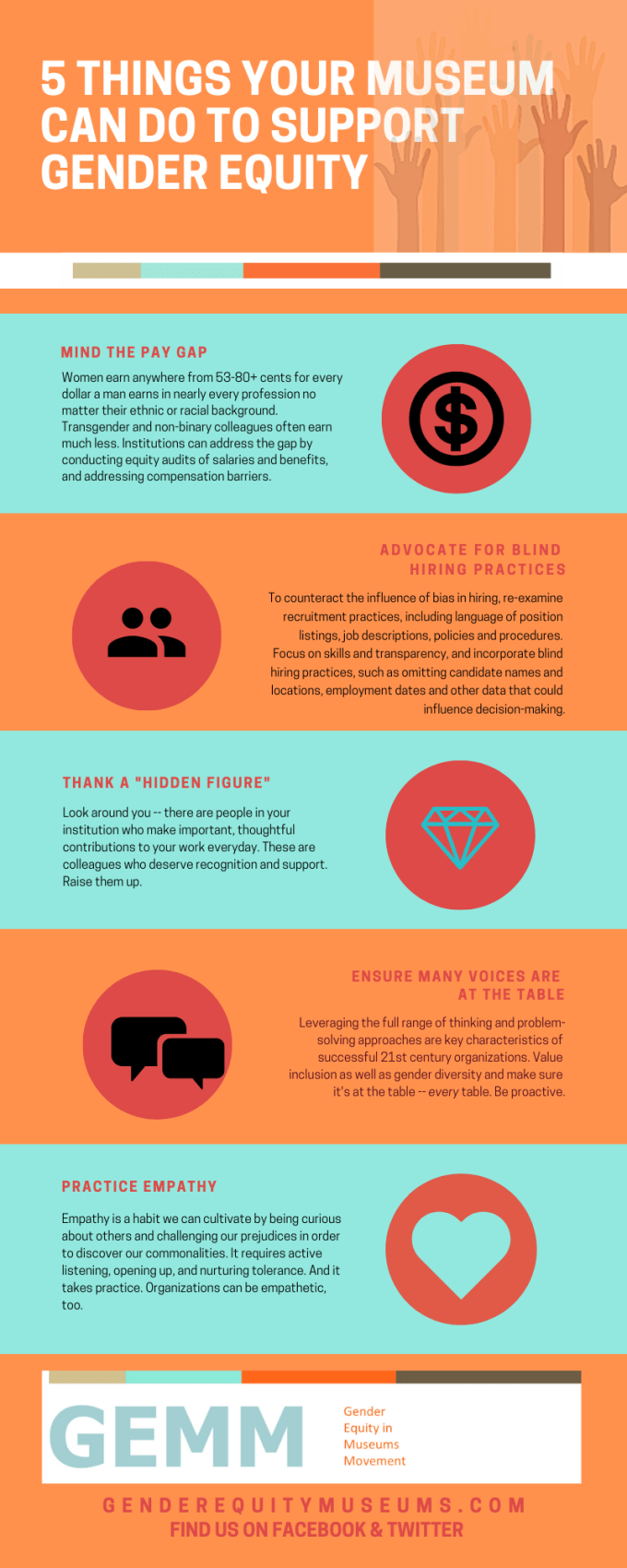
This week, my colleagues at GEMM (the Gender Equity in Museums Movement) published their second white paper, Museums as a Pink Collar Profession.
GEMM’s paper poses some complex questions about our field. Among other things, it asks whether our long struggle with poor pay has its roots in issues of deep-seated bias, and whether that bias produced today’s workforce. I suspect the answer is yes.
The Women’s Caucus organized for the first time at AAM’s 1973 Annual Meeting. Most of its participants were white, and unlike today, none of them would have openly identified as LGBTQ, since being out at work wasn’t always safe in 1973. Despite these shortcomings in perspective, the Caucus’s goals were simple and not dissimilar from GEMM’s today—support museum women, see them in positions of leadership, close the pay gap, and work for decent benefits including maternity leave.
Today, after 46 years, the museum world’s workforce is almost equally balanced for gender in employment, with 49.5 percent of museum workers being women in 2018, according to the Bureau of Labor Statistics (BLS).
Skip over related stories to continue reading articleBut pay issues continue to affect museum workers, as they have for decades. According to the BLS, in 2017 a museum worker’s median pay was $48,000/yr. That is significantly below the 2017 median incomes of $60,996, for bachelor’s degree holders, and $72,852, for master’s degree holders. And it’s likely not the first time it’s happened since 1973. Are there consequences for decades of low pay? Yes. One result is the field’s long slow slide toward becoming a pink collar profession.
Another may be that engaged, smart, creative folks leave when they realize that after taxes, graduate school loans, rent, and childcare there isn’t much left. What does that mean for the workforce? Clearly it affects diversity: You need to be privileged—whether by birth, marriage, or both—to invest in graduate school and then accept salaries and benefits of less-than.
Poor pay puts a strain on workers. It also keeps people in the field too long before they retire. Many must continue working to make retirement more than an exercise in how not to finish life in poverty. Think I’m kidding? If you don’t make much, you don’t have much to put away.
Then there is the gender pay gap. The median salary for all museum workers in 2017 was $48k, but, accounting for the pay gap, it would be even lower for women. And the gender pay gap isn’t just about women vs. men; it’s also about age, education, and most importantly race. The gap only gets larger for Black women (39 percent) and for Latinx women (47 percent.)
There is plenty to say about the museum workplace that isn’t about gender. And there’s plenty to say about gender that’s true for women everywhere, not just museum land. The gender gap exists everywhere. Statistics show women value job flexibility more than men, perhaps because women are still the primary caregivers, whether for children or elderly family members. As a result, they often accept lower pay rates in exchange for increased flexibility at work. Has this struggle for enough time—time to have a child, time to raise a child, or time to care for a sick family member—artificially depressed wages? And given our money-conscious society, do the museum world’s low wages devalue our profession?
So what are we left with? We have a workplace close to majority female overall, and already dominantly female in many positions, and we know, beyond a shadow of a doubt, that occupations with more women pay less. We have a workplace created, benignly or benevolently in some cases, with a minefield of roadblocks. The entrance ticket is a graduate degree. Once in the door, you discover a world where salaries are often confidential, with employees unaware that others in similar roles might receive far higher pay. You may suspect there’s a gender pay gap at your institution, but have no way to find out. You may uncover a world of staff offices and meeting rooms that are far more traditional, hierarchical, and patriarchal than you anticipated or could have imagined. You may find yourself sweetly, kindly, mansplained through staff meetings or told not to make a fuss if you experience bias because of your race or your gender or both.
Can the field change? We’d like to think so.
If you’re an individual:
- Be knowledgeable about museum salaries: Read Museums as a Pink Collar Profession. Know what it costs to live in your area, Use the AAM salary survey and know what others in your position make.
- Read your organization’s HR/personnel policy. Know what it means to you if you want to go back to school, become a parent, or need to care for an elderly relative.
- Know what to do if you’re harassed at work. Will you be supported?
- Stand up for your colleagues. #EnoughIsEnough
If you’re an organization:
- Do an equity salary audit. Look for inequities based on age, race, gender, and power. Think about the relationship between the executive director’s salary and the lowest full-time staff member. Solve these equity issues first. Raises are meaningless if they perpetuate the pay gap.
- Create a value statement about how your museum or heritage organization expects its employees to behave. Stand behind it.
- Review your HR/personnel policy. Does it reflect your whole staff or just some of them?
- Stand up for your staff. And if you’re the organization that pays equitable wages, say so. How different would that be in a job advertisement?
Let’s not wait 11 months until the next Women’s History Month to talk about women’s issues in the museum workplace. They’re here, they’re now. Nowhere are they more obvious than the paycheck, which is tangible proof of bias and inequity. Let’s change that.










Nothing in this document surprises me -I was one of the founders of the Women’s Caucus for Art in the 1970s – and I could foresee then that art history being a majority female profession would mean lower pay even than women in other humanities fields [MLA etc.], but with men dominating the top jobs all over, whether in museums or colleges and universities. Gradually more women are being hired in the Ivy League departments, and more women are becoming museum directors. Well-researched updates such as this report can only help by keeping all of us aware of these biases.
Related data on a study of participation rates of women on the boards of 25 organisations in Toronto, Ontario, Canada range from 0% to 66.7%, averaging 40.1%, as reported in the Toronto Star (newspaper) today, 14 November 2019. The museum-related examples were: Art Gallery of Ontario 40.7%, Heritage Toronto 52.2%, & Royal Ontario Museum 63.2%. The highest among all those surveyed was the Toronto Environmental Alliance at 66.7% of its Board members are women. We still have “a long way to go, . . .”